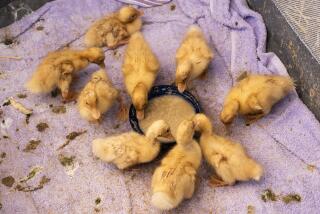Wild Goose Chase Is Just That
- Share via
At dawn, when Bob Wood scans Chatsworth Reservoir for Canada geese, he wonders where the wild things are.
Wood is on the board of directors of the Canada Goose Project, a group of wildlife enthusiasts who for a dozen years have been tracking the Canada geese that visit the San Fernando Valley. The Valley is the only place in the Greater Los Angeles metropolitan area where the geese regularly stop.
The 56-year-old West Hills man is dismayed by this year’s numbers. “We’ve been counting for the best part of two months, and we’ve had two counts of six to 10, and most of the time we’ve seen no geese,” Wood said. “This time last year we were seeing 200 to 300.”
Rosemarie White, president of the project, said the group was formed precisely because local environmentalists suspected a decline in the flocks of migratory geese stopping in the Valley during their annual flight south from Alaska and western Canada.
White and about 50 others began counting migratory geese at four locations in the Valley: the Chatsworth and Encino reservoirs, the Sepulveda Dam Recreation Area and the Pierce College campus in Woodland Hills.
In earlier days, White said, “The count was about 2,000 geese that were sleeping over at the Encino and Chatsworth reservoirs and flying out at about 6 o’clock in the morning to various spots in the San Fernando Valley to feed.”
White, who counts at Encino Reservoir, said she saw 353 Canada geese just before dawn on Sunday. Last year on Nov. 19 she counted 783.
“We’re very worried about it,” White said.
In the past, the bucolic Pierce College campus was a favorite place for the migratory geese to rest and dine on grass and other goose delights.
“We used to see them take off in that direction [south toward Pierce],” said Wood.
But he hasn’t seen a single migrating goose at Pierce this year. Wood said he suspects the birds aren’t stopping at the campus because construction or plowing has eliminated the large swaths of green that once covered it.
“Every single area they’ve been going to at Pierce has been disrupted,” White said.
Stephen Moe, water manager for the Valley region of the city’s Department of Recreation and Parks, said he has yet to see a migratory Canada goose in the Sepulveda Dam Recreation Area. There is a resident flock of 75 to 100 Canada geese that spends most of its time on the Woodley Lakes Golf Course, but there has been no evidence of transient geese.
Moe and the others think loss of habitat is probably to blame for any drop in the numbers of geese. “Over the last 100 years, man has destroyed over 95% of the resting and foraging areas,” Moe said.
White wonders if fewer geese are making the long journey along the Pacific flyway. She pointed out that thousands of Canada geese have been destroyed in the Seattle area in the last two years. The U.S. Department of Agriculture has killed several thousand there, saying their copious feces are a health hazard.
Kimball Garrett, manager of ornithology collections at the Natural History Museum of Los Angeles County, agrees that loss of habitat is a problem but believes other forces may also be at work: A relatively mild fall might have delayed the annual migration.
“It’s possible the whole contingent isn’t here yet,” Garrett said.
A recent cold snap could change that, he added.
Locally, the large, handsome birds seem to have more friends than foes.
Moe said he rarely hears gripes about the geese that hang out in the Sepulveda Dam Recreation Area.
“Out of a thousand people, we may have a complaint or two,” he said. “It may be a golfer who complains because his ball ran into a pile of goose feces or a fisherman who may be unhappy.
“But most people are in awe of them.”
More to Read
Sign up for Essential California
The most important California stories and recommendations in your inbox every morning.
You may occasionally receive promotional content from the Los Angeles Times.













